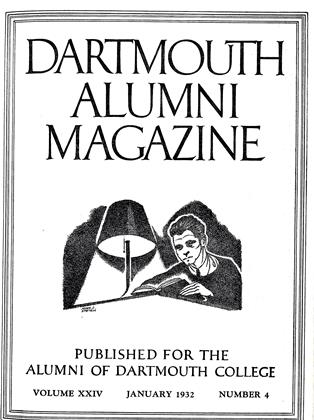ANOTHER of Dartmouth's pipe dreams has had a practical and happy ending with the construction of a building housing ten single courts and a doubles court for squash. Enough lovers of the game stayed with it, playing in handball courts that were far from satisfactory for squash, to persuade the Athletic Council that squash courts for Dartmouth were necessary and would meet with wide spread enthusiasm. Acting upon this idea, the Council voted $90,000 for the project and building was begun by the Brunswick Balke-Collender Company of New York and Chicago under the immediate supervision of Walter Kinsella, retired world's open squash champion. With the completion of this building in November, Dartmouth men now have the opportunity to play on courts that compare favorably with any in the Intercollegiate Squash League.
The new courts meet the specifications agreed upon by the National Squash Racquets Association and the National Squash Tennis Association in a joint meetingheld last year. By standardizing dimensions these bodies made it possible for either game to be played on one court. The single courts measure 32 feet long by 18 feet wide and have a telltale 18 inches high. The walls are 16 feet high to the service line, there dropping to 12.
The doubles court is 25 x 45. The new Dartmouth courts have been built incorporating a policy that has been very successful in the Yale Club in New York city. Rather than the usual white, the floors have the color of maple wood which has been twice shellacked and then treated with one coat of colorless spar varnish. The advantages of this type of flooring are many. There is no glare reflected from the floor to the player's eyes; the danger of slipping or falling is largely reduced because the surface of the floor is not slippery. The finish is sufficiently light to allow players to distinguish the ball, regardless of how fast the play may become. White floors had to be cleaned constantly because of black smudges made by players who wore dark-soled shoes. On the new floor dark smears are hardly discernable and few are seen since there is a rule in force that prohibits the wearing of dark-soled shoes. It is believed that the National Squash Racquet Association will recommend these floors in future construction of squash courts.
The method of ventilation installed in the Dartmouth squash courts is directly opposite to the system used in most squash houses. In each court there are two outlets through which stagnant air is sucked outside by a large machine for that purpose. Perfect modera lighting fixtures have been installed, in fact, the Athletic Council has spared no expense in giving Dartmouth men squash facilities that are on a parity with the best in the country.
Dartmouth's second step in the squash movement was to procure the services of Crawford L. Gilligan of the Fraternity Squash Club in New York city as coach. Mr. Gilligan is well suited to undertake the Dartmouth squash project as he has always been active in the sport, first as an amateur player and later as professional and coach. Aside from coaching squash, Mr. Gilligan is in charge of varsity tennis.
Due to a paucity of good material, it is doubtful if Dartmouth could give a real team much competition, so Coach Gilligan has planned one year of orientation before entering a team in the intercollegiate squash group composed of Harvard, Yale, Princeton, and M. I. T. This season will be devoted to classifying all players in four groups. Men in the highest group will be eligible for positions on next year's varsity team. This primary classification is temporary and later the ladder system will be used throughout the four groups. Each man will have the right to challenge the two men immediately above him in a three out of five game match and in time the true ranking of the players will manifest itself.
A few of the courts were opened on the 21st of October and so great was their popularity that a reservation board was installed, based on the principle used at squash clubs in various cities. Each man may play only one half-hour period, unless there is a vacancy in another court. In no circumstance is a man allowed to play for two periods if there are others waiting.
All the courts are now open, six of the singles courts and the doubles court being at the disposal of the faculty and student body at large and the other four singles courts being reserved for the use of men who have selected squash for their recreational activity. The courts are open from 9 in the morning to 9:30 in the evening, during which time the galleries as well as the courts are filled with enthusiasts.
Ranking among the finest in the Intercollegiate League, Dartmouth's new squash courts are worthy of the praise that is heard on all sides coming from zealous undergraduates and alumni. The faculty has already organized a team and schedule for this winter. Next year, Dartmouth, with a year of experience, will enter a team in the Intercollegiate Squash League.
C. L. GILLIGAN, COACH
SECOND FLOOR CORRIDOR
DAVIS FIELD HOUSE, SQUASH COURTS, ALUMNI GYMNASIUM, SPAULDING POOL
 View Full Issue
View Full Issue
More From This Issue
-
 Article
ArticleProgress and Prosperity: A Suggested Program
January 1932 By Adelbert Ames, Jr -
 Article
ArticleProgress and Prosperity: A Suggested Program
January 1932 By Adelbert Ames, Jr -
 Article
ArticleCommentary: Cabot on Ames
January 1932 By Philip Cabot -
 Article
ArticleCommentary: Cabot on Ames
January 1932 By Philip Cabot -
 Sports
SportsModern Ski Technique
January 1932 By Otto Schniebs, John W. McCrillis -
 Class Notes
Class NotesCLASS OF 1926
January 1932 By J. Branton Wallace








